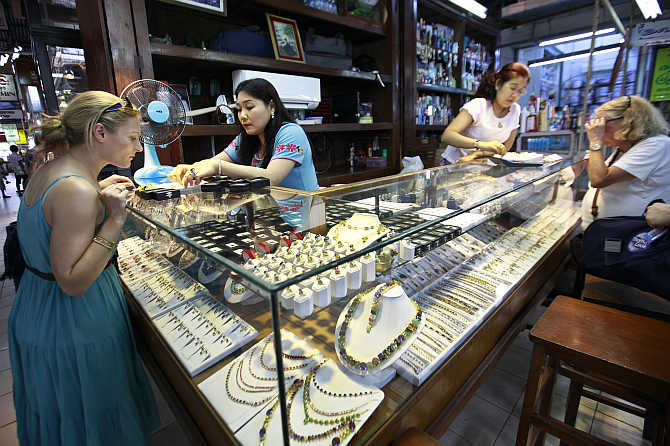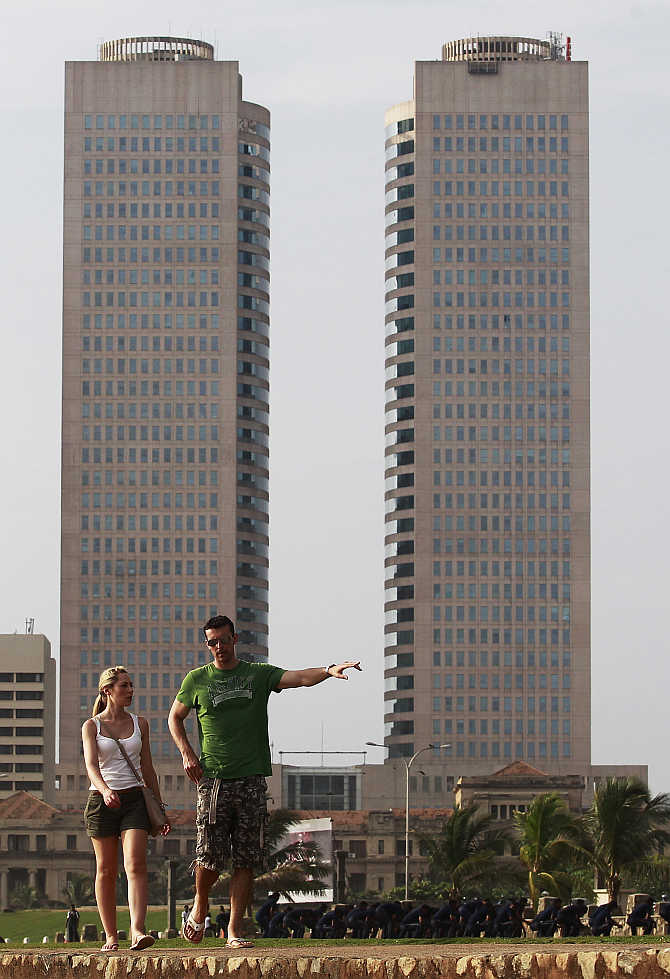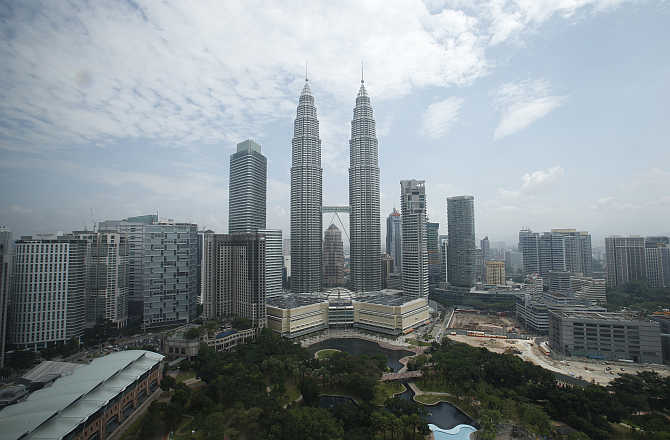Photographs: Anindito Mukherjee/Reuters TE Narasimhan in Chennai
Around 300 members of the Nattukottai Chettiar community, or Nagarathars, descended on Singapore for a two-day conference on November 23 and 24. They were businessmen and professionals who had come all the way from West Asia, Australia, Malaysia, Europe, US and - of course - India.
The list of attendees included community heavyweights like MV Subbiah, the former chairman of the Murugappa group, and Manickam Ramaswami, the chairman & CEO of Loyal Textiles. The objective of the conference was to motivate the younger generation of Nagarathars to become entrepreneurs. Presentations were made on how to build a global business network of Nagarathars and how to strengthen the “business culture” among the youngsters.
Business opportunities in various countries were discussed. A venture capital for the community was also suggested. Though the community is known for its male entrepreneurs, one session was dedicated to “young and woman entrepreneur’s challenges and aspirations”. The conference was organised because in the last two or three decades members of the community have veered away from business. If the trend is not arrested and reversed, the Nagarathars could soon turn from “employers to employees”.
...
From boss to worker: TN's top business community fights back
Image: Tourists look at jade and gems in a shop at Aung San market in Yangon, Myanmmar. The Nagarathars moved to Myanmmar in the 19th century.Photographs: Soe Zeya Tun/Reuters
Veterans from this community lament how the “native instincts to venture out and risk-taking aptitude is slowly vanishing in this community”. Starting as traders of salt, rice and other commodities, the Nagarathars over centuries developed substantial interests in services as well as industry. Their primary asset was their knowledge of numbers and integrity. The Nagarathars gave the country Indian Overseas Bank, Indian Bank, Bank of Madura, as also United India Insurance.
Union Finance Minister P Chidambaram hails from this community. The god-fearing community built more than 100 temples and tanks in Tamil Nadu. What Marwari businessmen are to the north and Parsees to the west, the Nagarathars are to the south.
The community is a prominent mercantile caste in Tamil Nadu. The Nagarathars hail from a place called Chettinad in the southeastern region of Tamil Nadu in the district of Sivaganga. At one time, they lived in 96 villages, but now due to migration their spread has diminished to about 75 villages. They began in the 18th century by trading salt produced in coastal districts in the inland towns and villages. From there they expanded to moneylending. They are considered the pioneers of modern banking. They introduced concepts like pattru (debit), varavu (credit), selavu (expenditure), laabam (profit) and nashtam (loss).
...
From boss to worker: TN's top business community fights back
Image: Tourists walk along a beach in the evening, in Colombo, Sri Lanka. The Nagarathars also branched out to Sri Lanka.Photographs: Dinuka Liyanawatte/Reuters
These are all collectively known as iynthogai (trial balance) - a unified document which reflects the current financial status of the business at any given time. They also had different lending rates for community members and for outsiders - something similar to the repo and reverse repo rates of present times.
Subsequently, in the 19th century, the Nagarathars moved out of India to foreign lands like Burma (now Myanmar), Ceylon (Sri Lanka), Java, Sumatra, Malaysia, Singapore and Saigon (Vietnam) for trade and lending. It was in Burma they grew tremendously as moneylenders. They went into interior Burma where European bankers wouldn’t venture, and became an important part of that country’s economic growth. Their wealth grew, and they became powerful in India.
The Nagarathars were the primary providers of capital to Burmese cultivators through much of the colonial period. The collapse of paddy prices in the Great Depression, coupled with the Nagarathars’ insistence on land as collateral, transferred a substantial part of Burma’s cultivatable land into their hands. Discontent against them ran high. Finally, the community was expelled from there during World War II. It has been reported that there is around Rs 100,000 crore worth of Nagarathar land in Myanmar. Today they own large coffee plantations in Karnataka.
...
From boss to worker: TN's top business community fights back
Image: A woman dressed in flower costumes participate in the11th Jember Fashion Carnival in Jember, Indonesia's East Java province. The community also flourished in Java.Photographs: Sigit Pamungkas/Reuters
From small time companies to big business conglomerates like the Chennai-based Rs 22,500-crore Murugappa group, Chettinad group, AVM Studios and the MAC group, the community has interests in manufacturing, banking, hospitality, fertiliser, films, paper, pharmaceuticals, sugar, food and several others sectors.
A chunk of Chettiar wealth lies in gold, plantations and real estate. The Nagarathars once dominated the southern film industry, spending lavishly on promoting the arts and Tamil isai (music). The late AV Meiyappa Chettiyar's century-old AVM is still one of the largest names in movie and television programme production in the region, while SAP Annamalai family’s Kumudam is one of the largest-circulating Tamil magazines. This community, in the past, put its faith on on-the-job training rather than formal education. Subbiah of the Murugappa group shared his experience (the way he came to the highest level) in a recent conference in Chennai.
A person will start as podiyan (office boy/peon) at the age of 13-17, go to the next level as aduthaal (clerk) in his early 20s, to kootali (agent) in his mid-20s, pangaali (partner) in his early-30s and mudalaali (owner) in his late-30s or early-40s.
...
From boss to worker: TN's top business community fights back
Image: A view of Malaysia's landmark Petronas Twin Towers against an almost clear sky in Kuala Lumpur. Nagarathars also found home in Malaysia.Photographs: Bazuki Muhammad/Reuters
The interesting part, adds Nagappan Valliappan, who runs one of the leading stock broking firms in Chennai called Oriental Stocks and is one of the directors of the Madras Stock Exchange, is that despite the fact that the training happens in the father's organisation, you will be not be given any special consideration and you have to work under someone who may not be a part of the family, though he would be a part of the business for few decades.
“It’s all about discipline and experience,” says Nagappan.Nowadays, the community feels, young Nagarathars choose to hone their skills at B-schools rather than learning at their father’s work table. Nagappan recalls how his business instinct sprang up on an opportunity when he was still a teenager: his father had offered to pay Rs 2 lakh for an MBBS seat in Manipal; Nagappan chose to do BCom instead but took the Rs 2 lakh to start a cement agency, his first business venture.
Like Nagappan, other senior representatives from this community feel that the younger generation is not willing to take risks and its members prefer to become employees. Today, Nagarathars are employed as professionals across the globe - in more than 50 countries. Some may call it the inability of the elders to cope with change, but the fears run deep.
...
From boss to worker: TN's top business community fights back
Image: A model presents a creation by Indian designer Devki Karer for label DEVKI's in Singapore. The community also flourished in Singapore.Photographs: Tim Chong/Reuters
To change this mindset, the community for the first time held the Singapore conference with a complete focus on how to bring back the entrepreneurship skill sets. R Narayanamohan, chairman, Singapore Indian Chamber of Commerce and Industry, said in the conference that parents no longer encourage children to get into the family business.
This mindset needs to be changed. Chockalingam Palaniappan, founder of Prakala Wealth Management, echoed this view stating that today Nagarathar parents are obsessed with engineering and medicine, and they hardly encourage children to study commerce or business which is in their blood. “We all are at this conference to create an atmosphere that will encourage entrepreneurship in our community. The first and foremost is access to capital for budding entrepreneurs,” he says.
To solve the problem, he suggested forming an investment group with angel investors on the one side and entrepreneurs on the other. The moot question: will the elders be able to stem the tide? Will the younger Nagarathars get back to where it all started? Palaces, plantations and jewellery are what Nagarathars like to invest in. Kaanadukathan, about 450km from Chennai, is one of the best destinations to see Nagarathar architecture.
...
From boss to worker: TN's top business community fights back
Image: Women walk next to a Louis Vuitton sign as they enter the luxury Trang Tien Plaza shopping mall in Hanoi, Vietnam. The community is also present in Vietnam.Photographs: Kham/Reuters
The streets of this now almost deserted town are dotted with houses built on a palatial scale. Each one of them sits on a large plot of land that spreads over 1.5 to 10 acres and has many as 1,000-1,500 windows. The centre of attraction is the 110-year-old Chettinad Palace. Built by Annamalai Chettiyar about 200 years ago, it is the oldest surviving building in the town.
The construction material, decorative items and furnishings were imported from East Asia and Europe. The marble was brought from Italy, chandeliers and teak from Myanmar, crockery from Indonesia, crystal from Europe and wall-to-wall mirrors from Belgium. The woodwork and stonework were inspired by houses in France and other European countries.
Those days ships could not take the load of the huge tree trunks, so the logs were tied together behind ships and they would float in water, says a local. A demolished house can produce as much 1,800 tonnes of timber, he says. Sadly, these houses are disappearing fast. It takes a lot of money to maintain them - Rs 10 lakh every three to four years, says an owner. Increasingly, these houses are being demolished to make way for smaller, compact buildings.









article